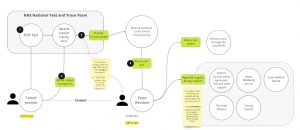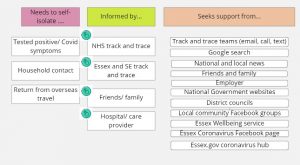If you test positive for Coronavirus (COVID-19) or get pinged by NHS Test and Trace, you must self-isolate by law.
The problem
There was a concern that Essex residents might not be self-isolating when they should. We needed to understand if this was the case and if so, why not? Did they understand the rules? Did they know what support was available to them while they were isolating? How was this support being offered?
Our public health colleagues asked for help, so we stepped into the breach. Speed was of the essence.
The work

This work was always going to be led by research.
Within 3 weeks we’d conducted a research review, an open card sort, and a round of face-to-face testing with residents. This allowed us to identify pain points and gaps in information. This is what we learned:
Explore the whole journey

Through our research, we explored how users would find what we were creating, and what their experiences would be after having found it. This helped us identify areas where we needed to better direct residents to the right support, and where blockers and pain points needed to be removed. To do this, we had to not only plan our own content, but reach out to borough and district councils, as well as partner organisations, to make the user journey the best it could be.
User research is everyone’s business
At least one person from the team observed each and every user research session; our service designer explored social media feedback from residents, and our interaction designer conducted a user research session (armed with a discussion guide and background support from the team’s user researcher). We tested emails, voice messages, letters from the local test and trace team. We also tested content on our website and signposting links.

If you keep iterating the challenges get smaller
When we first came together, the problem was clear, but our approach was wide open. So, we organised ourselves.
- Stakeholder conversations set a goal and kept us on track
- Involving different disciplines brought in expertise
- Adopting an agile and iterative approach allowed us to deliver fast
What went well
Working to a tight deadline can be challenging and requires dedication. In our case, it brought the team closer together. Using Teams and a shared online work board allowed each of the professions to share insights with the others. Rapid prototyping helped everyone visualise each iteration, which could then be tested again with real users.
Teamwork makes the dream work
After each research activity, designers and researchers came together to consider what action was needed based on what we learnt. At times, it felt like we were helping each other with a large jigsaw puzzle: when the user researcher identified a key insight for the work (one piece of the puzzle), the service designer would see this and add their own adjacent piece, based on their work and expertise. We had not each taken on our own corner of the puzzle, hoping to join up in the middle! Drawing on the team’s range of skills, enabled us to work in these productive short, agile cycles that yielded the quick results that were needed.
Trust and support from our sponsor
Throughout this work, our sponsors in public health actively supported us—we believe this was critical to this work running smoothly. They:
- Gave us a clear problem to solve - we knew exactly what was expected of us and why we were doing it
- Trusted our expertise - the problem was clear, but there was infinite openness in how we met this problem. This allowed us to follow service design principles throughout, which included adapting and changing the problem statement as the work unfolded
- Provided dedicated support – they assigned us a dedicated project manager, to connect with the right people, remove blockers and give clout and legitimacy to the work we were doing
What impact have we had?
On the team
We now have a better understanding of how our professions complement each other. Knowing this will help us deliver more quickly on future projects.
On residents
Quick iterations and implementations, and testing our assumptions meant we were able to get the information residents needed about self-isolating out quickly.
For wider stakeholders
We have shared what we learned with other services, to support a more seamless user journey.
How will we measure our impact?
In the coming weeks and months we’ll periodically review the content, using data and feedback from users and stakeholders. In a fast-changing landscape, we need to make sure our users get the right information at the right time, in the right place.
You can view some of the outcomes of this work on essex.gov: Find out what you must do and how to get support if you are self-isolating because you have tested positive or have symptoms of coronavirus.
Contributors: Chanel Chomse, Narelle Ong, Sarah Lieutenant and Caroline McCabe
Leave a comment